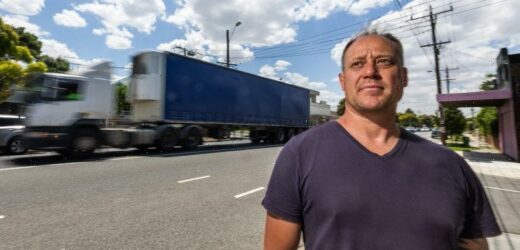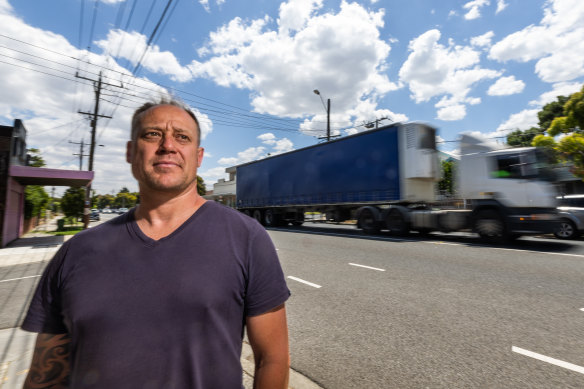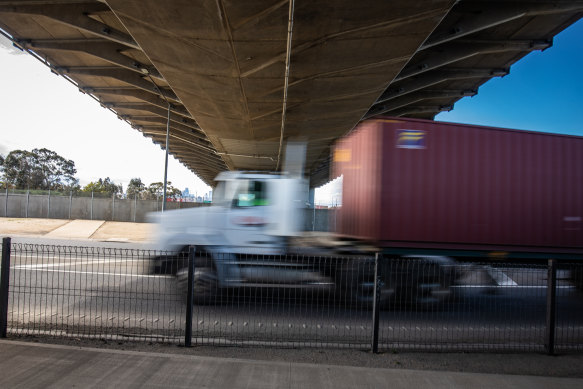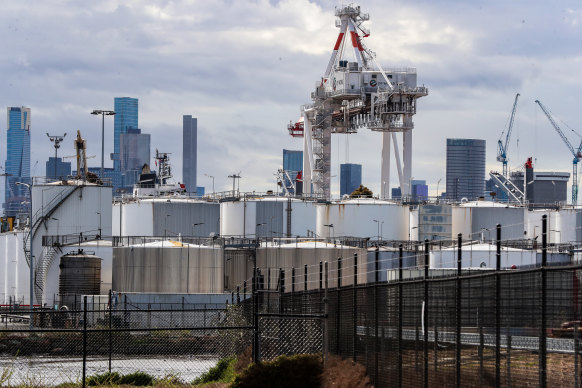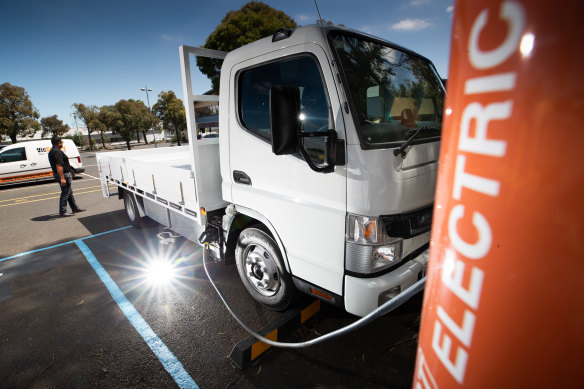Glen Yates is 46 years old with two children, his youngest in primary school. He doesn’t smoke and is of average weight, but recently he’s been diagnosed with a suite of health problems, including asthma.
“I had some issues with my heart, which then led to finding a blood clot in one of my lungs,” he says.
Glen Yates lives in Yarraville near Somerville Road, one of Melbourne’s busy residential freight routes.Credit:Jason South
Yates’ Yarraville house is 20 metres off Somerville Road, one of Melbourne’s main residential freight routes.
Chronic illnesses such as his are consistent with those caused by exposure to diesel exhaust. Where he lives in the City of Maribyrnong, the rate of freight travel to and from the Port of Melbourne is estimated at 11,000 trucks a day, according to a state government-commissioned report.
By 2050, that number is estimated to reach 34,000 a day.
Experts have long warned that if international air quality standards aren’t met, we will face a preventable public health emergency. Global warming is worsening the problem. Governments know this, yet have been slow to act.
An investigation by the Centre for Advancing Journalism, not-for-profit media organisation Right Now and The Age has tracked a timeline of pledges by the Andrews government to tackle air hazards in Melbourne’s inner west against its record of delivery. It’s a record of missed deadlines, delays and dilutions over years.
Respiratory expert Louis Irving says we have reached a tipping point when it comes to vulnerable people’s exposure to air pollution.
“It’s already a crisis,” says the Royal Melbourne Hospital physician. “[Those vulnerable are] the very young, the very elderly, people with chronic heart or lung disease, pregnant people.”
Air pollution is complex, but its effect on humans can be explained simply. In urban areas, the air we breathe is polluted with damaging chemicals caused by industry emissions, construction debris, coal-fired energy plants, bushfire smoke, wood heaters and vehicle exhaust.
Diesel exhaust contains a cocktail of particulate matter, most of which is harder to measure and more harmful to human health.Credit:Scott McNaughton
The most harmful pollutant is particulate matter, made up of toxic chemicals, black carbon and heavy metals such as mercury. Particulates are inhaled into the lungs and absorbed straight into the bloodstream.
From there, they can become lodged in tissue and organs.
The smaller the particle, the harder it is to measure and the more harmful it is to human health. Coarse particulate matter (PM10) is 10 micrometres in diameter and comes mostly from organic matter like dust, while PM2.5 is four times smaller and most often produced by vehicle engines.
PM1 and PM0.1 are ultrafine particulate matter and cannot be measured by the Victorian Environment Protection Agency’s monitoring stations. Diesel exhaust contains a cocktail of particulate matter, 80-95 per cent of which is ultrafine. The World Health Organisation states that no amount of exposure to PM2.5 or smaller is safe.
Trucks use main residential streets in the inner west to access the Port of Melbourne.Credit:Paul Jeffers
In 2019, 1780 Australians died prematurely from PM2.5 vehicle emissions, according to the State of Global Air. That figure is 49 per cent higher than the annual national road toll.
Air pollution in Melbourne’s inner west has a motley pedigree. Industry – accounting for 18 per cent of the area’s zoning – pumps out organic compounds and chemicals. Dust from construction debris and unsealed roads generates coarse particulate matter.
But the biggest problem the area faces is the ultrafine particles from diesel trucks. Freight trucks use main residential streets such as Somerville and Williamstown roads to access the Port of Melbourne, pumping particulates into nearby houses, schools and childcare centres.
The WHO standard for hourly PM2.5 concentration is 15 micrograms per cubic metre. In Glen Yates’ Yarraville home, his air monitors sometimes show spikes between 40 and 70 micrograms per cubic metre.
The state government estimates 11,000 trucks travel through the City of Maribyrnong a day to and from the Port of Melbourne.Credit:Paul Rovere
Community activist groups such as Save Willy Road and the Maribyrnong Trucking Action Group (MTAG) have been campaigning on this issue for decades. Over the years, they have watched as other countries “greened” their ports and decarbonised transport networks.
Victoria has one of the oldest trucking fleets in the Organisation for Economic Co-operation and Development. According to an August 2022 Grattan Institute report, 14 per cent of the fleet was manufactured before 1996, and emits 60 times the particulate matter of a new truck.
In late October, then environment minister Lily D’Ambrosio pledged $15 million to subsidise truck modernisation, with owners to receive up to $20,000 to upgrade their vehicle.
But MTAG president Martin Wurt questioned if the modest funds would really get the biggest-polluting trucks off the streets. An electric vehicle start-up recently estimated it cost $150,000 to convert an older diesel semi-trailer into an electric truck.
“If you upgrade your truck, what happens to the old one?” Wurt says. “Does that get sold on and someone else is going to drive a crappy old truck?”
A spokesperson from the Department of Energy, Land, Water and Planning (DELWP) did not respond to questions about truck modernisation or scrapping details.
In 2018, the Andrews government formed a group of experts and residents to focus on community concerns. The Inner West Air Quality Community Reference Group was given two years and $60,000 to produce a report detailing the air pollution problems faced by the inner west, and provide solutions.
What the group found was far worse than expected.
The City of Maribyrnong has a population that skews young, with a median age of 35, compared to the state average of 38, according to 2021 census data. Yet Maribyrnong residents are being hospitalised with respiratory and cardiovascular issues in significant numbers compared with the rest of Australia, according to Deakin University research.
Admissions for heart failure, stroke, asthma, heart and pulmonary diseases all well exceeded the Australian average, the research, led by child health expert Dr Kate Lycett and cited by the reference group, shows.
The government ignored most of the reference group’s comprehensive list of mitigation strategies for the inner west, which included short, medium and long-term recommendations, with priority emphasis on regulatory reform across state and federal bodies, low emission vehicle zones, a clean port program and public transport improvements. Instead, the strategy highlighted five pre-existing infrastructure projects to “protect and improve local air quality”.
All five are “big builds” – the signature achievements of the Andrews government’s three terms in office – which include the Melbourne Metro Rail Tunnel Project and West Gate Tunnel Project. Some of these were announced seven years ago.
Health and infrastructure experts say the two big build rail projects will reduce pollution in the inner west.
The $58 million Port Shuttle Network and $125 million set for associated rail works at the port, will enable freight to be moved to outer hubs at Somerton, Altona and Dandenong South via shuttle train rather than truck. Last week, the government welcomed news a private consortium planned to build a freight terminal at Somerton, about 30 kilometres north of Melbourne’s CBD, to be operational by 2025.
But experts note that the full benefits of the shuttle network to those living near the port – the network is projected to transport 30 per cent of Melbourne’s containers by 2050 – are still a generation away and that other tunnel and road projects underway will make existing pollution problems worse.
The government claims the West Gate Tunnel Project, which is now expected to cost $10 billion, will provide a solution as it will funnel underground more than 9000 trucks which would otherwise use residential streets.
But Dr Lyn Denison, a technical adviser and the former principal scientist at the EPA, said in 2017 the project would not remove the trucks from residential roads, just push them on to different streets.
Tom McCarthy and his young family bought a Yarraville house in 2016.
“[I am] frustrated that the only local childcare centres with any availability for my daughter are close to, if not right on, high-volume truck routes,” he says.
“I don’t understand how this is being allowed. It seems plain negligent.”
The Andrews government hopes to increase the use of electric trucks. Credit:Jason South
Irving, from the Royal Melbourne Hospital, says diesel pollution is a class-one carcinogen and implicated in the development of lung cancer over many years of exposure.
But with asthma, it’s much quicker, as traffic pollution causes new and worsening pre-existing asthma. Children exposed to air pollution are at risk of diminished adult lung capacity, Irving says, and a faster rate of effective ageing.
When asked about the government’s preventative health measures, the DELWP spokesperson pointed instead to the broader strategy and a $1.8 million two-year initiative for children with asthma.
Despite the readily available data from four years of initiatives, the government’s Clean Air Strategy contains a new commitment of $2.8 million for the area to “identify and implement” solutions to particulate pollution.
Air purifiers installed in state schools as part of the government’s pandemic response have had a fortuitous effect on air quality in classrooms on truck thoroughfares. These high-efficiency purifiers are capable of washing out particles as small as PM1 from the air, meaning they filter out diesel exhaust and COVID-19.
This is important, as schools have been identified as particularly sensitive locations. A planned Deakin University “citizen science” initiative, Breathe Melbourne, has been designed to collect data and educate children and parents about air quality in their suburbs. The project, modelled on a flagship London initiative, was originally slated to be introduced into schools for the last term of last year but was postponed until the first term of 2023.
Two sources with detailed knowledge of the program, who requested anonymity to protect their positions, told The Age government officials gagged external communication about the project in the final months of 2022.
The spokesperson for DELWP referred questions about the project to Deakin University. The university did not respond to inquiries.
During the 2020 bushfires, Melburnians saw what a future with hazardous air quality looks like. On one hazy day, the city had the worst air quality in the world.
This is one way the problem of truck pollution will worsen as the planet warms. A 2013 study published in peer-reviewed clinical journal Chest shows that climate change influences weather events such as bushfires, heavy rainfall and thunderstorms; weather conditions that increase levels of particulate matter and worsen respiratory problems such as asthma.
Atmospheric chemist Robyn Schofield says Australia isn’t taking the easy steps to mitigate air pollution.
“That costs us a large amount of money in terms of health,” says the University of Melbourne’s associate dean of environment and sustainability.
At least 3000 deaths per year are attributed to air pollution in Australia, according to information published in British medical journal The Lancet, and $11-24 billion in health costs.
Despite the return of the Andrews government in last year’s election, with an increased majority in the lower house, Labor experienced a large swing against it in the seat of Footscray, where sitting member Katie Hall’s primary vote dropped by 12 per cent. The swing was widely interpreted as a sign those in historically working-class suburbs, previously ultra-safe Labor seats, felt angry and overlooked.
Yates says we won’t be able to ignore the pollution issue for much longer.
He says the government will “hold the door [on air pollution data closed] as much as they can, but there’s too much weight behind it now”.
This investigation is by students at the University of Melbourne’s Centre for Advancing Journalism, supported by independent media not-for-profit Right Now.
Get to the heart of what’s happening with climate change and the environment. Our fortnightly Environment newsletter brings you the news, the issues and the solutions. Sign up here.
Most Viewed in National
From our partners
Source: Read Full Article
